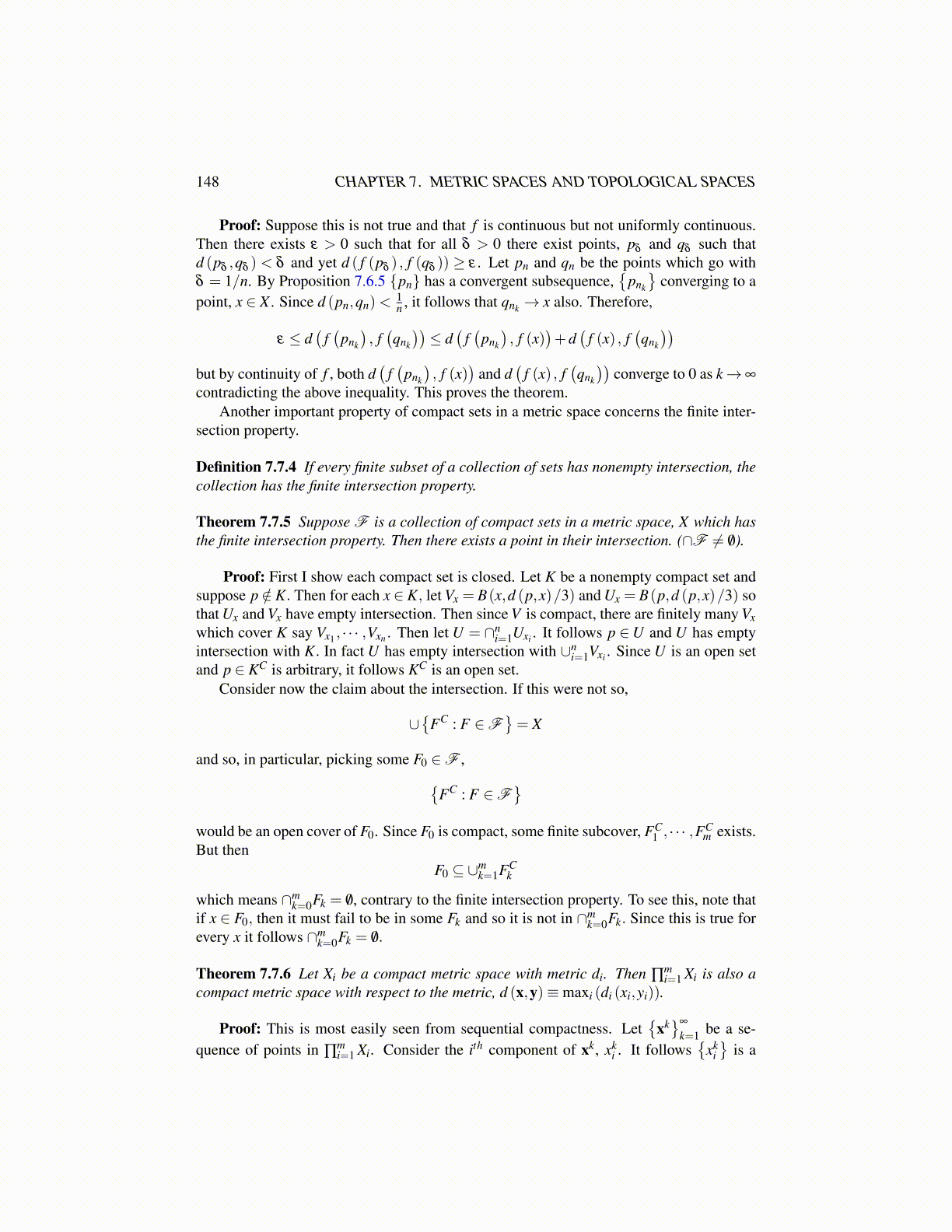
148 CHAPTER 7. METRIC SPACES AND TOPOLOGICAL SPACES
Proof: Suppose this is not true and that f is continuous but not uniformly continuous.Then there exists ε > 0 such that for all δ > 0 there exist points, pδ and qδ such thatd (pδ ,qδ ) < δ and yet d ( f (pδ ) , f (qδ )) ≥ ε . Let pn and qn be the points which go withδ = 1/n. By Proposition 7.6.5 {pn} has a convergent subsequence,
{pnk
}converging to a
point, x ∈ X . Since d (pn,qn)<1n , it follows that qnk → x also. Therefore,
ε ≤ d(
f(
pnk
), f(qnk
))≤ d
(f(
pnk
), f (x)
)+d(
f (x) , f(qnk
))but by continuity of f , both d
(f(
pnk
), f (x)
)and d
(f (x) , f
(qnk
))converge to 0 as k→∞
contradicting the above inequality. This proves the theorem.Another important property of compact sets in a metric space concerns the finite inter-
section property.
Definition 7.7.4 If every finite subset of a collection of sets has nonempty intersection, thecollection has the finite intersection property.
Theorem 7.7.5 Suppose F is a collection of compact sets in a metric space, X which hasthe finite intersection property. Then there exists a point in their intersection. (∩F ̸= /0).
Proof: First I show each compact set is closed. Let K be a nonempty compact set andsuppose p /∈ K. Then for each x ∈ K, let Vx = B(x,d (p,x)/3) and Ux = B(p,d (p,x)/3) sothat Ux and Vx have empty intersection. Then since V is compact, there are finitely many Vxwhich cover K say Vx1 , · · · ,Vxn . Then let U = ∩n
i=1Uxi . It follows p ∈U and U has emptyintersection with K. In fact U has empty intersection with ∪n
i=1Vxi . Since U is an open setand p ∈ KC is arbitrary, it follows KC is an open set.
Consider now the claim about the intersection. If this were not so,
∪{
FC : F ∈F}= X
and so, in particular, picking some F0 ∈F ,{FC : F ∈F
}would be an open cover of F0. Since F0 is compact, some finite subcover, FC
1 , · · · ,FCm exists.
But thenF0 ⊆ ∪m
k=1FCk
which means ∩mk=0Fk = /0, contrary to the finite intersection property. To see this, note that
if x ∈ F0, then it must fail to be in some Fk and so it is not in ∩mk=0Fk. Since this is true for
every x it follows ∩mk=0Fk = /0.
Theorem 7.7.6 Let Xi be a compact metric space with metric di. Then ∏mi=1 Xi is also a
compact metric space with respect to the metric, d (x,y)≡maxi (di (xi,yi)).
Proof: This is most easily seen from sequential compactness. Let{
xk}∞
k=1 be a se-quence of points in ∏
mi=1 Xi. Consider the ith component of xk, xk
i . It follows{
xki}
is a